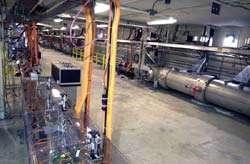Jefferson Lab’s Upgraded Free-Electron Laser Produces First Light

A view inside JLab’s Free-Electron Laser vault, showing the upgraded linear accelerator on the right and the infrared wiggler magnet on the left.
Researchers at the U.S. Department of Energy’s Thomas Jefferson National Accelerator Facility have produced first light from their 10 kilowatt Free-Electron Laser (FEL). This device has been upgraded from the “one kilowatt Infrared Demonstration” FEL, which broke power records by delivering 2,100 watts of infrared light during 2001. Only one and one-half years after the one kilowatt FEL was dismantled, the newly improved FEL, designed to produce 10 kilowatts of infrared and one kilowatt of ultraviolet light, is undergoing commissioning toward the goal of producing 10 kilowatts by summer’s end.
According to Rear Admiral Jay Cohen, Chief of Naval Research, “This project builds on the successful seven-year partnership forged between the Office of Science’s Jefferson Lab and the Office of Naval Research. The original kilowatt FEL exceeded the Navy’s goals and expectations and we expect no less from the upgraded FEL.”
The Free-Electron Laser upgrade project is funded by the Department of Defense’s Office of Naval Research (ONR), Air Force Research Laboratory and the Joint Technology Office. Jefferson Lab is managed for the Department of Energy’s Office of Science by a consortium of universities in the southeast called the Southeastern Universities Research Association.
To enable experimenters to probe deep inside the atom’s nucleus with electrons, Jefferson Lab pioneered superconducting technology for accelerating electrons to high energy in efficient, cost-effective accelerators. Jefferson Lab’s superconducting electron-accelerating technology offers two commanding cost advantages for FELs: the laser can stay on 100% of the time instead of only 1% or 2%, and more than 90% of the energy that is not converted to useful light in a single pass can be recycled.
The Navy’s interest in this technology is the development and demonstration of an electrically driven tunable laser that can operate at infrared wavelengths where light is most efficiently transmitted in the atmosphere for potential applications toward shipboard defense.
During the two and one-half years the so-called one-kilowatt FEL operated, it broke all existing power records for tunable high-average power lasers. It was used by more than 30 different research groups representing the Navy, NASA, universities and industry for a variety of applications ranging from the investigation of new cost-effective methods for producing carbon nanotubes and understanding the dynamics of hydrogen defects in silicon to investigating how proteins transport energy. These research groups are eagerly awaiting the newly upgraded FEL and are making plans for its use.
For additional information, contact Thomas Jefferson National Accelerator Facility (Jefferson Lab), Newport News, Virginia or the Office of Naval Research:
Linda Ware (ware@jlab.org)
Jefferson Lab Public Affairs Manager
(757) 269-7689 (fax: 7398)
Gail Cleere, (cleereg@onr.navy.mil)
ONR Public Affairs Officer
(703) 696-4987
Media Contact
More Information:
http://www.jlab.org/news/archive/2003/firstlight.htmlAll latest news from the category: Physics and Astronomy
This area deals with the fundamental laws and building blocks of nature and how they interact, the properties and the behavior of matter, and research into space and time and their structures.
innovations-report provides in-depth reports and articles on subjects such as astrophysics, laser technologies, nuclear, quantum, particle and solid-state physics, nanotechnologies, planetary research and findings (Mars, Venus) and developments related to the Hubble Telescope.
Newest articles

Innovative 3D printed scaffolds offer new hope for bone healing
Researchers at the Institute for Bioengineering of Catalonia have developed novel 3D printed PLA-CaP scaffolds that promote blood vessel formation, ensuring better healing and regeneration of bone tissue. Bone is…

The surprising role of gut infection in Alzheimer’s disease
ASU- and Banner Alzheimer’s Institute-led study implicates link between a common virus and the disease, which travels from the gut to the brain and may be a target for antiviral…

Molecular gardening: New enzymes discovered for protein modification pruning
How deubiquitinases USP53 and USP54 cleave long polyubiquitin chains and how the former is linked to liver disease in children. Deubiquitinases (DUBs) are enzymes used by cells to trim protein…


